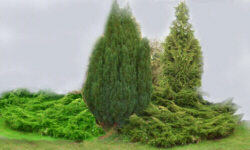JunipersTrees.com - Using
Junipers in the Garden
Using Junipers in the garden
is usually a matter of personal taste, but on this page
I offer some suggestions for effective garden use of junipers
to get the best out of these striking and exciting plants.
In England I have used junipers successfully in various
planting schemes, gardens and landscaping situations,
but you should be able to adapt my methods to suit whichever
country you live in. Below are some different approaches
to using junipers, but first a plea about how not to use
them.
How not to use junipers in your garden
 In
England at least there is a commonly seen arrangement
involving junipers that appears in numerous front gardens
in particular. This consists of one, two or three upright
conifers (usually Chamaecyparis lawsoniana 'Ellwoodii'
or 'Fletcheri' or a golden lawson variety) together with
one, two or three semi-prostrate junipers (often Juniperus
X media 'Pfitzeriana Aurea') growing around the bases
of the upright conifers. (See the example pictured left).
In
England at least there is a commonly seen arrangement
involving junipers that appears in numerous front gardens
in particular. This consists of one, two or three upright
conifers (usually Chamaecyparis lawsoniana 'Ellwoodii'
or 'Fletcheri' or a golden lawson variety) together with
one, two or three semi-prostrate junipers (often Juniperus
X media 'Pfitzeriana Aurea') growing around the bases
of the upright conifers. (See the example pictured left).
While there is nothing wrong as such with this 'look'
it does tend to be repeated almost everywhere ad nauseum,
and in my opinion it is better to do something new and
different. This arrangement also has no obvious connection
with any style of  garden,
or design purpose; it is simply something that arose through
the almost-chance planting or grouping together of the
most commonly available conifer varieties in nurseries
of the 1950s, '60s and '70s. Once seen in a few places
in those early days (and presumably admired then as something
'new') it was copied by many home owners who knew no other
way to design a conifer group or conifer-featured garden.
garden,
or design purpose; it is simply something that arose through
the almost-chance planting or grouping together of the
most commonly available conifer varieties in nurseries
of the 1950s, '60s and '70s. Once seen in a few places
in those early days (and presumably admired then as something
'new') it was copied by many home owners who knew no other
way to design a conifer group or conifer-featured garden.
Note that I am not decrying the conifer varieties used
in this arrangement, only the arrangement itself.
Right: One way to use junipers effectively - Junipers
growing with heathers and alpines in a modern upland or
hill country garden designed by the author of this site
(the grass could be removed though!)
| Using Junipers in an upland wild
garden
You do not need to live in the hills or mountains
of the Peak District, Dartmoor, or the Rocky Mountains
for that matter, but if you do, so much the better.
A garden of this kind can be rocky and wet in climate
(such as gardens of the English Lake District, where
Juniperous communis grows wild amongst the ferns
and rocks) or rocky and dry (such as the gardens
of New Mexico). If you can make use of local junipers
and other plants you will aid the natural effect
considerably, blurring your garden landscape into
the wilds beyond (or on the other side of the next
block).
Try to plant 'wild' plants or their relatives that
associate well with junipers, such as heather (Erica
and Calluna), phylodoce, Gaultheria, Pernettya,
dwarf rhododendrons, Vaccinium, ferns and a whole
range of creeping, herbaceous and shrubby alpine
plants. Creeping thymes in particular associate
well with junipers, as do sedums. Large rocks strategically
placed can be very effective in this kind of garden,
as can old logs for a more 'woodlandy' feel.
Juniperus sabina 'Tamariscifolia' and similar Juniperus
sabina cultivars such as 'Rockery Gem', 'Broadmoor',
and 'Blue Danube' have been selected from the wild
in southern Russia and nearby countries where they
grow naturally in rocky and mountainous situations.
In general lower growing plants (NOT upright junipers)
occur naturally in mountain country.
|
|


Buy this Ferns Group / more info 
|
Using Junipers by the Ocean: seaside gardens
Again, it is not necessary to live by the sea to create
an effective garden with a seaside flavour, but it does
lend authenticity and unity to the project. Wide use of
suitable gravel to match the shingle of the shore, rounded
stones and boulders, as well as old straight timbers to
simulate breakwaters and wrecked ships timbers give a
good effect. So do water-worn branches and pieces of driftwood.
As with an upland garden, it is important to observe
the plants and habitat of a real seashore in order to
get this kind of garden right. Make use of seaside plants
amongst the junipers, such as sea kale, horned poppy,
eryingium (sea holly), as well as suitable alpines and
even herbs. Adapt your choice of plants to your climate
and soil. Use Juniperus conferta varieties extensively,
as this grows wild on seashores in Japan.

Junipers and succulents in a seaside garden
in East Anglia that I designed. |

Junipers and grasses in a contemporary garden. |
|
Using Junipers in 'Contemporary Gardens'
Contemporary gardens often use minimalist planting
and formal design. Their origins lie in creating
spaces that complement modernist buldings. In a
garden of this kind 'fussiness' is to avoided; simplicity
of layout and use of contemporary landscaping materials
and 'fashionable plants' such as ornamental grasses
and Phormium tenax (right), is to be encouraged.
Do not attempt this kind of garden unless your house
or apartment lends itself to the design in some
way, unless you desire to create a clashing effect
that will forever be an eye-sore.
Ground-hugging junipers in the contemporary garden
can be very effective alongside paving of different
textures and shades of colour, or beside steps.
The Green Mound
Juniper, Juniperus procumbens 'Nana' looks particularly
fine in this situation, as do Juniperus conferta
varieties.
|
|


Buy Phormium / more info 
|


Buy Japanese blue Iris / more info 
|
Upright junipers can be used to create 'punctuation
marks' in the flow of a garden of this kind. Use
junipers such as Juniperus chinensis 'Stricta',
Juniperus scopulorum 'Skyrocket',
Juniperus communis 'Hibernica' (see image top right
of this page), Juniperus chinensis 'Monarch', or
for a golden upright form, Juniperus chinensis 'Aurea'.
But be aware that these upright forms have a powerful
effect upon the eye, stopping its movement across
a design, and potentially creating a 'jarring' effect
unless used wisely. Do NOT dot then here and there;
rather use them to arrest the eye for some purpose,
such as to direct the attention to a feature of
some kind. Alternatively, and to lessen the 'jarring'
effect, plant them as a group.
In steel or metal-effect containers silver-blue
junipers can be very striking, for example the neat
upright form of Juniperus chinensis 'Stricta' or
Juniperus scopulorum 'Skyrocket'.
Other possibilities are Juniperus squamata 'Blue
Star' for its intensely silver-blue foliage
- plant this one in a wider or box-shaped metal
container. To complement or bring out the blue colour
of such junipers plant them near to blue-flowered
plants such as the blue iris illustrated left.
|
|
With Bamboos
Due to their feathery informal nature, bamboos
can associate well with junipers in some situations.
At all times the ultimate size of the bamboos being
used and their tendency to spread and droop sideways
should be born in mind, for foliage of any kind
lying on juniper foliage will usually result in
brown patches.
However, used as a backdrop, or with a few dwarf
bamboos here and there amogst junipers, the effect
can be very good indeed in a contemporary garden
or elsewhere, the flimsier foliage of the bamboo
lightening and relieving the more solid, heavier
appearance of some junipers.
Mulched with gravel and a few selected cobbles
or round stones such an arrangement can be used
in a seaside garden and also verges on the effects
used in some Japanese gardens.
|
|


Buy a Bamboo Collection / click for more info

|
|
Using junipers in formal gardens
Formal gardens are gardens that use hard landscaping
and design in straight lines, squares, rectangles
and other geometric shapes. They do not aspire to
or pretend to be 'natural' or 'wild' arrangements
but are usually designed to compliment the lines
of a building, or even to reflect a philosophical
idea.
There are many types of formal gardens, and at
one end of the scale they even merge into cottage
gardens, where the straight lines of paths and rustic
archways are softened by rather chaotic planting.
The occasional large juniper probably looks best
in this kind of garden, such as Juniperus chinensis
'Pyramidalis', or Juniperouus scopulorum 'Blue Moon';
while a formal effect can be achieved in troughs
and gravel with the Noah's Ark Juniper, Juniperous
communis 'compressa'.
|
|


Buy this Windsor Arch - more info 
|
Juniper Resources
and where to buy:
Bonsai
Boy of NY
Very large supplier of bonsai trees and equipment in USA,
with many juniper bonsai
trees available.
|
Juniper Trees.
com
Welcome to JuniperTrees.com, your Number
One Source of information about Junipers and
where to buy these beautiful plants for your garden.
We provide plant and growing information for the
most popular garden Junipers as well as information
about Junipers
as bonsai trees and herbal products made from
Juniper berries.
Visit us now for everything Juniper!
|
Trees
Under $30
Bonsai trees, including junipers, under $30 from Bonsai
Boy of New York.
Click
here to give a great gift - a tree!
Tree gifts and memorial tree planting from TreeGivers.
How to grow Junipers
How to grow junipers - cultivation of junipers in the
open and in containers.
Juniper Resources and
Links
Good juniper resources and links.
Link to this site
Add an extra resource about junipers for your visitors.
| Note: The information
on this page is based on personal experience and preference
in growing junipers in England, and no guarantees
of success or otherwise can be given if you follow
this advice. Your experiences, climate, country and
garden situation may be different, and you are responsible
for your own successful planting schemes or failed
ones. |
Go
Back
Juniper
Trees
Disclaimer
| Link
to Us | Contact
Us
Text and Images Copyright
©  junipertrees.com and on behalf of individual copyright
owners.
junipertrees.com and on behalf of individual copyright
owners.
All Rights Reserved.
This using junipers in the
garden page belongs to http://www.junipertrees.com/